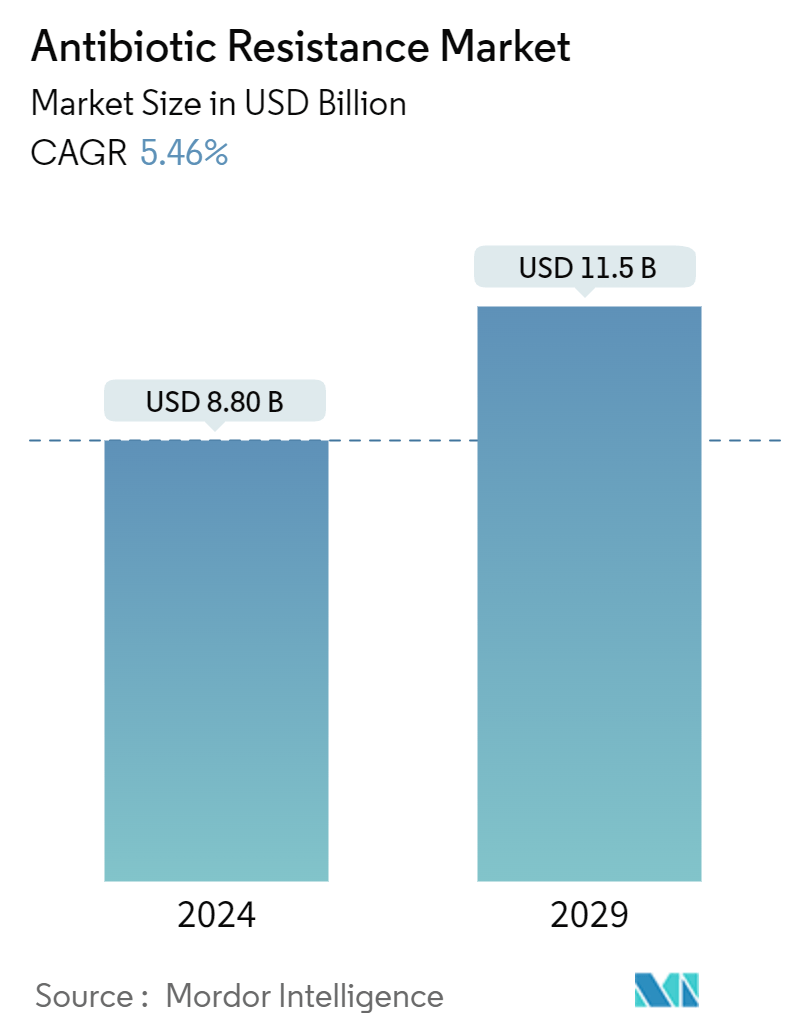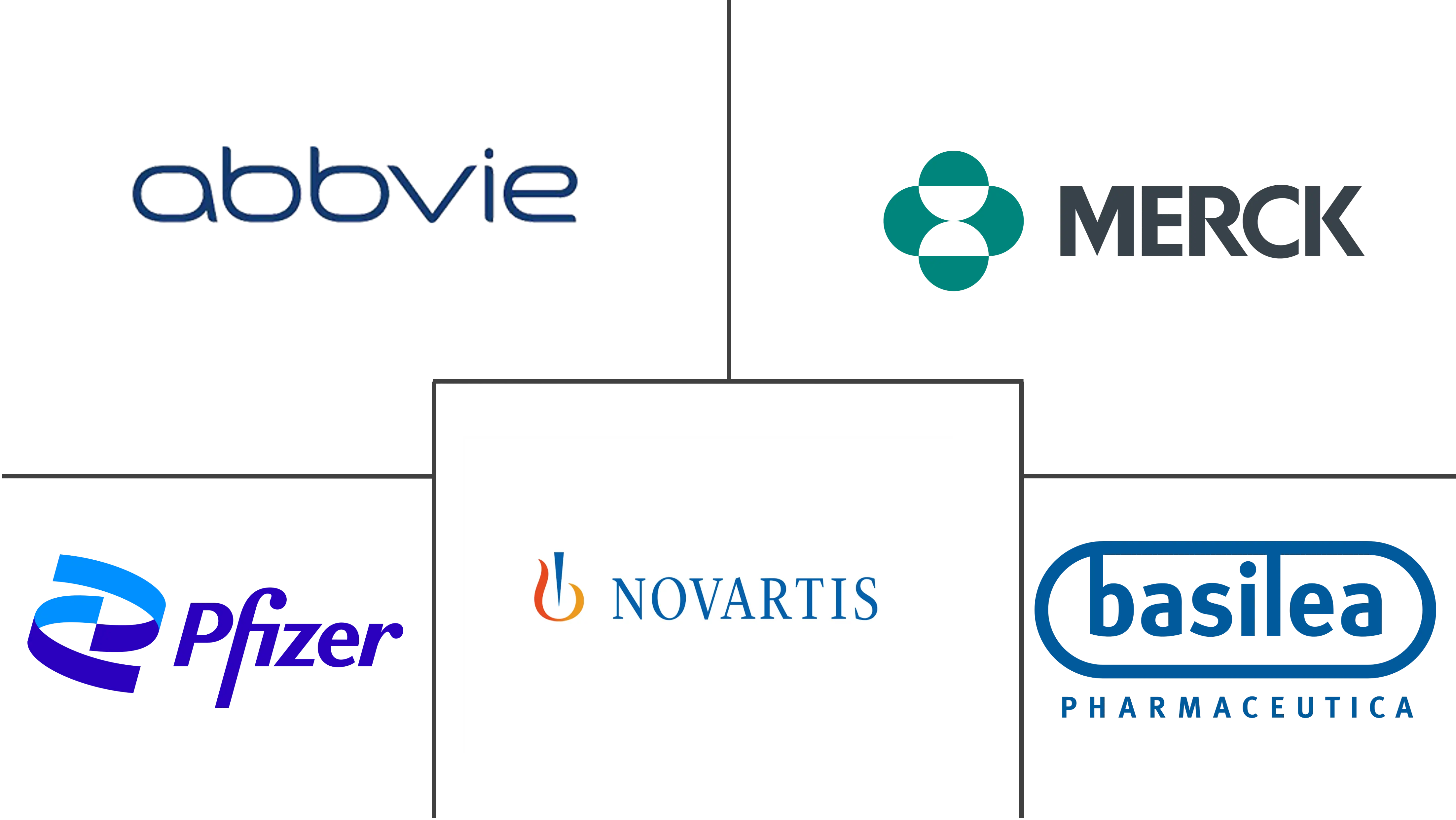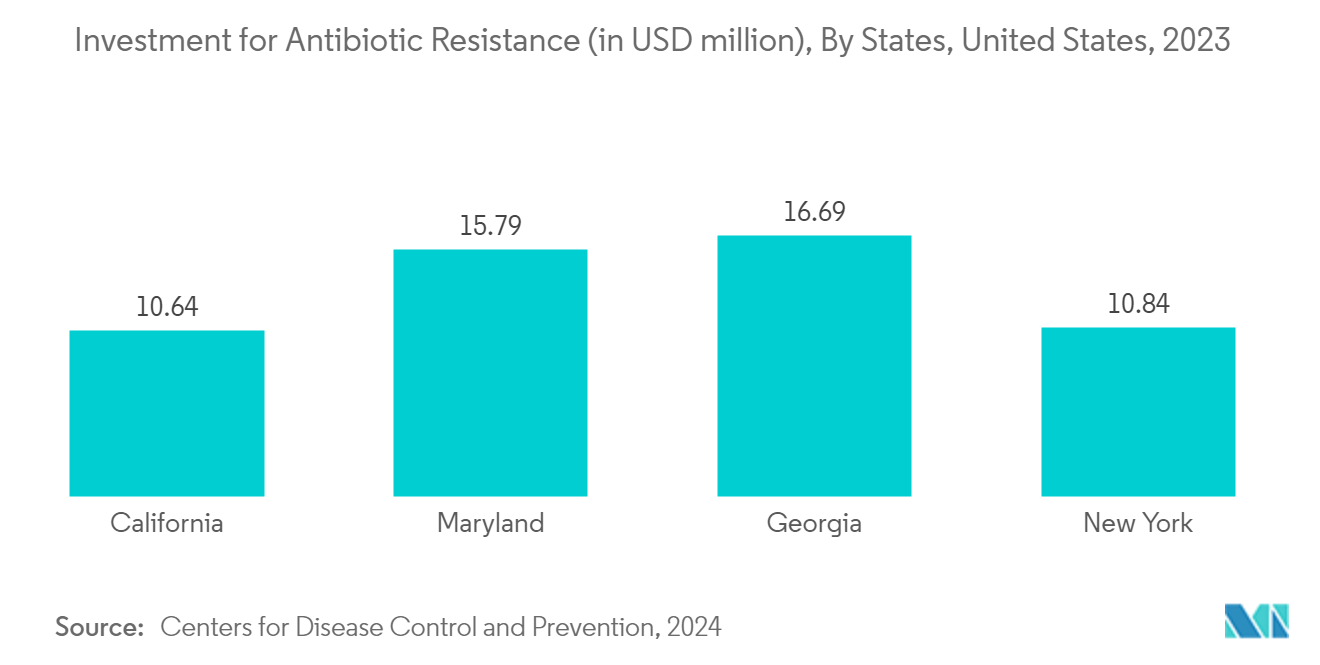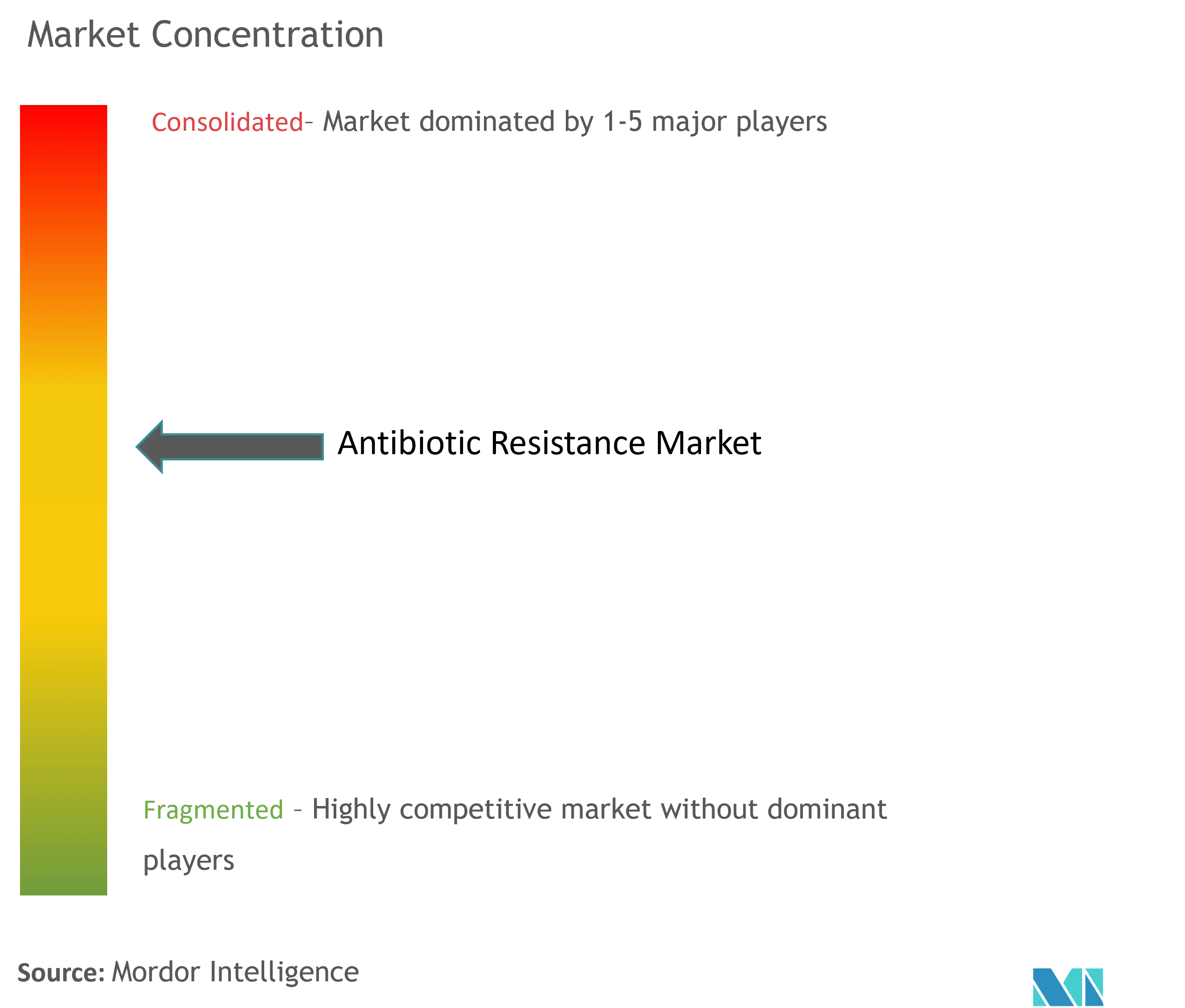Antibiotic Resistance Market Size

| Study Period | 2019 - 2029 |
| Market Size (2024) | USD 8.80 Billion |
| Market Size (2029) | USD 11.5 Billion |
| CAGR (2024 - 2029) | 5.46 % |
| Fastest Growing Market | Asia Pacific |
| Largest Market | North America |
Major Players
*Disclaimer: Major Players sorted in no particular order |
Antibiotic Resistance Market Analysis
The Antibiotic Resistance Market size is estimated at USD 8.80 billion in 2024, and is expected to reach USD 11.5 billion by 2029, growing at a CAGR of 5.46% during the forecast period (2024-2029).
The key drivers of the market are the increasing burden of antibiotic-resistant infections across developed and developing regions and a shift in prescription patterns to newly launched therapies.
The increasing involvement of government and non-government bodies in developing novel therapies is anticipated to drive market growth. The high burden of antibiotic-resistant infections is a major concern globally. For instance, according to the CDC's data published in October 2022, more than 2.8 million antimicrobial-resistant infections occur each year in the United States, and more than 35,000 people die as a result of antibiotic resistance.
Moreover, in February 2023, the Australian government raised USD 6 million in funds for research into antimicrobial resistance and reducing the incidence of hospital infections. This grant opportunity was announced as part of the Medical Research Future Fund (MRFF) under the Global Health Initiative. Thus, such government initiatives are expected to boost the market's growth over the forecast period.
Some major companies operating in the AMR are adopting several strategies, such as collaboration and acquisition, along with various launches to strengthen their positions in the market. For instance, in January 2023, Alkem Laboratories launched an antibiotic, Zidavi, for multiple drug-resistant (MDR) infections. Moreover, in January 2023, Molbio Diagnostics launched Truenat MTB-INH to test the presence of isoniazid resistance in Mycobacterium tuberculosis in infection (MDR-TB). The test was validated by ICMR and approved by CDSCO, which can provide sample-to-test results in an hour.
The high burden of antibiotic resistance, the launch of new drugs for antibiotic-resistant infections, and initiatives taken by government are propelling the market growth. However, strict safety guidelines and the high cost of AMR therapeutics are expected to hinder the market's growth.
Antibiotic Resistance Market Trends
The Complicated UTIs Segment is Expected to Hold a Major Share of the Market
The prevalence of complicated UTIs is expected to hold a major share in the market, owing to the rise in drug-resistant bacteria and excessive use of antibiotics. A complicated UTI is any urinary tract infection other than a simple UTI. Therefore, all urinary tract infections in immunocompromised patients, males, and those associated with fevers, stones, sepsis, urinary obstruction, catheters, or involving the kidneys are considered complicated infections.
The study published in May 2023 in the National Library of Medicine showed that 150 million cases of UTI occur globally per year, causing morbidity and mortality. Also, the article published in StatPearls and updated in November 2023 highlighted that in the United States, around 1.8% of hospitalizations are due to complicated UTIs. Such a high burden of disease creates the need for drugs for treatment, driving the growth of the segment.
In February 2024, Allecra Therapeutics received US Food and Drug Administration (FDA) approval for Exblifep. It is a cefepime/enmetazobactam that can be used to treat complicated urinary tract infections (cUTIs), including pyelonephritis, in patients 18 years of age and older.
Therefore, owing to factors such as the rising burden of complicated UTIs and increasing pipeline activities to treat complicated UTIs, the segment is expected to witness significant growth in the future.

North America is Expected to Hold a Significant Market Share Over the Forecast Period
North America is expected to dominate the antibiotic resistance market over the forecast period. The market is growing in the region due to the high population resistant to antibiotics, high consumption of antibiotics, and increasing funding for research and development.
The increasing burden of antibiotic resistance in the region is expected to increase the demand for its therapy, which is expected to boost the market's growth over the forecast period. For instance, as per an article published in Global News in November 2022, in Canada, about 26% of infections that occur are resistant to first-line antibiotics. Resistance is expected to grow exponentially in the coming years, from 40% to 100% resistance to first-line antibiotics and antifungals by 2050. Thus, the increasing burden of antibiotic resistance in the country is expected to drive the growth of the antibiotic resistance market over the forecast period.
Increased funding and awards for AMR projects are expected to boost the market's growth in the region. For instance, in May 2024, the CDC invested USD 7.13 million in Minnesota to combat antimicrobial resistance. Thus, such initiatives are expected to boost the market's growth over the forecast period.
Therefore, the market is anticipated to witness growth in North America due to the factors mentioned above.

Antibiotic Resistance Industry Overview
The antibiotic resistance market is moderately consolidated. Increasing innovation and investment for various public and private organizations are expected to intensify market rivalry worldwide. The players collaborate with other players to develop and promote their products and thus gain recognition in the market. The major players in the market include AbbVie, collaborating Merck & Co. Inc., Pfizer Inc., Novartis AG, and Basilea Pharmaceutica Ltd.
Antibiotic Resistance Market Leaders
-
AbbVie
-
Merck & Co. Inc.
-
Pfizer Inc
-
Novartis AG
-
Basilea Pharmaceutica Ltd.
*Disclaimer: Major Players sorted in no particular order

Antibiotic Resistance Market News
- January 2023: An Indian company, Alkem, launched its new antibiotic drug against multiple drug-resistant infections in the country. The company's product, Zidavi, is a novel combination of ceftazidime and avibactam and is indicated for various ailments like complicated urinary tract infections.
- May 2023: The UK government announced up to GBP 39 million (USD 50.11 million) cash for antimicrobial resistance (AMR) research through the Global AMR Innovation Fund (GAMRIF).
Antibiotic Resistance Market Report - Table of Contents
1. INTRODUCTION
- 1.1 Study Assumptions and Market Definition
- 1.2 Scope of the Study
2. RESEARCH METHODOLOGY
3. EXECUTIVE SUMMARY
4. MARKET DYNAMICS
- 4.1 Market Overview
-
4.2 Market Drivers
- 4.2.1 High Burden of Antibiotic Resistant Infections
- 4.2.2 Increase in Global Initiatives Drives New Drug Development
-
4.3 Market Restraints
- 4.3.1 Strict Safety Guidelines
- 4.3.2 High Cost of AMR Therapeutics
-
4.4 Porter's Five Forces Analysis
- 4.4.1 Bargaining Power of Buyers/Consumers
- 4.4.2 Bargaining Power of Suppliers
- 4.4.3 Threat of New Entrants
- 4.4.4 Threat of Substitute Products
- 4.4.5 Intensity of Competitive Rivalry
5. MARKET SEGMENTATION (Market Size by Value - USD)
-
5.1 By Disease
- 5.1.1 Clostridioides Difficile Infection (CDI)
- 5.1.2 Complicated Intra-Abdominal Infection (cIAI)
- 5.1.3 Acute Bacterial Skin and Skin Structure Infections (ABSSSI)
- 5.1.4 Hospital-Acquired and Ventilator-Associated Bacterial Pneumonias (HABP)
- 5.1.5 Complicated Urinary Tract Infection (cUTI)
- 5.1.6 Community-Acquired Pneumonia (CABP)
- 5.1.7 Bloodstream Infection (BSI)
-
5.2 By Pathogen
- 5.2.1 Acinetobacter baumannii
- 5.2.2 Staphylococcus aureus
- 5.2.3 Pseudomonas aeruginosa
- 5.2.4 Haemophilus influenzae
- 5.2.5 E. Coli
- 5.2.6 Other Pathogens
-
5.3 By Drug Class
- 5.3.1 Tetracyclines
- 5.3.2 Oxazolidinones
- 5.3.3 Cephalosporins
- 5.3.4 Lipoglycopeptides
- 5.3.5 Combination therpaies
- 5.3.6 Other Drug Classes
-
5.4 By Mechanism of Action
- 5.4.1 Cell Wall Synthesis Inhibitors
- 5.4.2 Protein Synthesis Inhibitors
- 5.4.3 DNA Synthesis Inhibitors
- 5.4.4 RNA synthesis inhibitors
- 5.4.5 Other Mechanisms of Action
-
5.5 By Distribution Channel
- 5.5.1 Hospital Pharmacies
- 5.5.2 Retail Pharmacies
- 5.5.3 Online Pharmacies
-
5.6 Geography
- 5.6.1 North America
- 5.6.1.1 United States
- 5.6.1.2 Canada
- 5.6.1.3 Mexico
- 5.6.2 Europe
- 5.6.2.1 Germany
- 5.6.2.2 United Kingdom
- 5.6.2.3 France
- 5.6.2.4 Italy
- 5.6.2.5 Spain
- 5.6.2.6 Rest of Europe
- 5.6.3 Asia-Pacific
- 5.6.3.1 China
- 5.6.3.2 Japan
- 5.6.3.3 India
- 5.6.3.4 Australia
- 5.6.3.5 South Korea
- 5.6.3.6 Rest of Asia-Pacific
- 5.6.4 Middle East and Africa
- 5.6.4.1 GCC
- 5.6.4.2 South Africa
- 5.6.4.3 Rest of Middle East and Africa
- 5.6.5 South America
- 5.6.5.1 Brazil
- 5.6.5.2 Argentina
- 5.6.5.3 Rest of South America
6. COMPETITIVE LANDSCAPE
-
6.1 Company Profiles
- 6.1.1 AbbVie
- 6.1.2 Merck & Co. Inc.
- 6.1.3 Pfizer Inc
- 6.1.4 Novartis AG
- 6.1.5 Basilea Pharmaceutica Ltd
- 6.1.6 MELINTA THERAPEUTICS
- 6.1.7 Theravance Biopharma
- 6.1.8 WOCKHARDT
- 6.1.9 Entasis therapeutics
- 6.1.10 Paratek Pharmaceuticals Inc.
- 6.1.11 Seres Therapeutics
- *List Not Exhaustive
7. MARKET OPPORTUNITIES AND FUTURE TRENDS
** Subject To AvailablityAntibiotic Resistance Industry Segmentation
As per the scope of the report, antibiotic resistance occurs when bacteria change in response to the use of these medicines. These bacteria may infect humans and animals, and the infections they cause are harder to treat than those caused by non-resistant bacteria.
The antibiotic Resistance market is segmented by disease, pathogen, mechanism of action, drug class, distribution channel, and geography. By disease, the market is sub-segmented into Clostridioides difficile infection (CDI), complicated intra-abdominal infection (cIAI), acute bacterial skin and skin structure infections (ABSSSI), hospital-acquired and ventilator-associated bacterial pneumonias (HABP), complicated urinary tract infection (cUTI), community-acquired pneumonia (CABP), and bloodstream infection (BSI)). By pathogen, the market is sub-segmented into Acinetobacter baumannii, Staphylococcus aureus, Pseudomonas aeruginosa, Haemophilus influenzae, E. coli, and other pathogens. By drug class, the market is sub-segmented into Tetracyclines, Oxazolidinones, Cephalosporins, Lipoglycopeptides, Combination therapies, and other drug classes. By the mechanism of action, the market is sub-segmented into cell wall synthesis inhibitors, protein synthesis inhibitors, DNA synthesis inhibitors, RNA synthesis inhibitors, and others. By distribution channel, the market is sub-segmented into hospital pharmacies, retail pharmacies, and online pharmacies. By geography, the market is sub-segmented into North America, Europe, Asia-Pacific, the Middle East and Africa, and South America. The report also covers the market sizes and forecasts in 17 countries across major regions. For each segment, the market sizing and forecasts were made on the basis of revenue (USD).
| By Disease | Clostridioides Difficile Infection (CDI) | |
| Complicated Intra-Abdominal Infection (cIAI) | ||
| Acute Bacterial Skin and Skin Structure Infections (ABSSSI) | ||
| Hospital-Acquired and Ventilator-Associated Bacterial Pneumonias (HABP) | ||
| Complicated Urinary Tract Infection (cUTI) | ||
| Community-Acquired Pneumonia (CABP) | ||
| Bloodstream Infection (BSI) | ||
| By Pathogen | Acinetobacter baumannii | |
| Staphylococcus aureus | ||
| Pseudomonas aeruginosa | ||
| Haemophilus influenzae | ||
| E. Coli | ||
| Other Pathogens | ||
| By Drug Class | Tetracyclines | |
| Oxazolidinones | ||
| Cephalosporins | ||
| Lipoglycopeptides | ||
| Combination therpaies | ||
| Other Drug Classes | ||
| By Mechanism of Action | Cell Wall Synthesis Inhibitors | |
| Protein Synthesis Inhibitors | ||
| DNA Synthesis Inhibitors | ||
| RNA synthesis inhibitors | ||
| Other Mechanisms of Action | ||
| By Distribution Channel | Hospital Pharmacies | |
| Retail Pharmacies | ||
| Online Pharmacies | ||
| Geography | North America | United States |
| Canada | ||
| Mexico | ||
| Geography | Europe | Germany |
| United Kingdom | ||
| France | ||
| Italy | ||
| Spain | ||
| Rest of Europe | ||
| Geography | Asia-Pacific | China |
| Japan | ||
| India | ||
| Australia | ||
| South Korea | ||
| Rest of Asia-Pacific | ||
| Geography | Middle East and Africa | GCC |
| South Africa | ||
| Rest of Middle East and Africa | ||
| Geography | South America | Brazil |
| Argentina | ||
| Rest of South America |
Antibiotic Resistance Market Research FAQs
How big is the Antibiotic Resistance Market?
The Antibiotic Resistance Market size is expected to reach USD 8.80 billion in 2024 and grow at a CAGR of 5.46% to reach USD 11.5 billion by 2029.
What is the current Antibiotic Resistance Market size?
In 2024, the Antibiotic Resistance Market size is expected to reach USD 8.80 billion.
Who are the key players in Antibiotic Resistance Market?
AbbVie, Merck & Co. Inc., Pfizer Inc, Novartis AG and Basilea Pharmaceutica Ltd. are the major companies operating in the Antibiotic Resistance Market.
Which is the fastest growing region in Antibiotic Resistance Market?
Asia Pacific is estimated to grow at the highest CAGR over the forecast period (2024-2029).
Which region has the biggest share in Antibiotic Resistance Market?
In 2024, the North America accounts for the largest market share in Antibiotic Resistance Market.
What years does this Antibiotic Resistance Market cover, and what was the market size in 2023?
In 2023, the Antibiotic Resistance Market size was estimated at USD 8.32 billion. The report covers the Antibiotic Resistance Market historical market size for years: 2019, 2020, 2021, 2022 and 2023. The report also forecasts the Antibiotic Resistance Market size for years: 2024, 2025, 2026, 2027, 2028 and 2029.
Antibiotic Resistance Industry Report
Statistics for the 2024 Antibiotic Resistance market share, size and revenue growth rate, created by Mordor Intelligence™ Industry Reports. Antibiotic Resistance analysis includes a market forecast outlook to for 2024 to 2029 and historical overview. Get a sample of this industry analysis as a free report PDF download.



